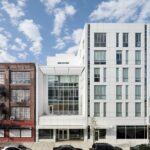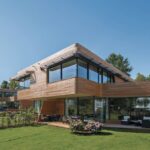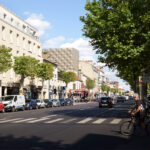Milanofiori Housing Complex, Milan Homes Images, Residential Development Italy
Milanofiori Housing : Residential Development Milan
Milanofiori building design by OBR Open Building Research, Italy
23 Nov 2011
Interview with OBR Open Building Research regarding their Milanofiori Housing
Design: OBR Open Building Research
The Milanofiori Housing was the overall winner for Leaf Awards in 2011
Interview with Paolo Brescia and Tommaso Principi from OBR
OBR Open Building Research founding partners Paolo Brescia and Tommaso Principi:

photo from OBR Open Building Research
Milanofiori Residential Complex
QUESTIONS FOR OBR REGARDING Milanofiori Residential Complex
The building has a duality in its presence, the internal and external façade differ greatly – how did you arrive at this composition? What inspired the concept?
In the idea of OBR Open Building Research that the building would have to tune itself in accordance to the site’s characteristics. For this reason the two main facades are designed differently: the one facing the street outside is more urban and conceived as a shell, while the one towards the inner common garden is more porous.

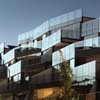
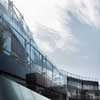
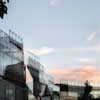
photos from OBR Open Building Research
The design of the urban facade stimulates the auto-identification by the inhabitants thanks to the composition of white frames which identify separately the units. These frames include vertical wooden panels of different widths which can slide across the frames and control the inner light and the intimacy to the night areas as necessary.
The facade overlooking the garden features double glazed bioclimatic greenhouses. The geometry of the external glass of the greenhouse has been designed to create kaleidoscopic effects overlapping the reflection of the public garden outside with the transparency of the private garden inside. In this sense the project has been significantly inspired by the result of the artistic research of Dan Graham on merging figure and background and reversing constantly their roles.
In turn, how did you integrate the project into the landscape and the masterplan by Erick van Egeraat, achieving synthesis between the urban and natural landscape?
The Milanofiori masterplan is characterized by a series of functions (offices, hotels, restaurants, cinemas, leisure, residences) that define together a cluster whose elements appear to follow the characteristics of the surrounding landscape creating a public park as the extension of the existing forest.
Our design for the residential complex seeks the symbiosis between architecture and landscape, so that the synthesis of artificial and natural elements could define the quality of living and the sense of belonging by the inhabitants.
The interface between the building and the garden becomes the field where interaction between man and environment takes place. This interface is defined by both the “C” form of the housing complex which encompasses the common garden, and the porosity from interior to exterior that characterizes each apartment.
How did you define the geometry of the facades? The visual layering is complex, what was the manner in which you rationalised aesthetic and practical considerations?
The geometry of the building is shaped by translation of the upper levels in line with positions of optimum solar exposure and by tapering of the external terraces in order to increase introspection among residents.
The green house has a double value: an environmental value in providing a buffer zone which allows thermal regulation, and an architectural value in extending the inner living space towards the outer landscape (and vice versa) permitting different uses from winter to summer. Closing the external glass in winter the green house works as a winter garden saving energy in heating thanks to the solar sun exposition, while opening it in summer it offers shadow to the inner façade protecting from the excessive sunlight.
We were looking in extending the façade normally conceived as a two-dimensional layer composed by walls and windows into a space, as a tree-dimensional layer open both to the interior and to the exterior that allows you to live new kind of hybrid situation of exchange.
Through the overlap of different natural layers (the common garden and the private gardens in the open terraces and in the green house), the project seeks a kind of a holism of nature, where various personal interactions of these natural layers create an intensive landscape that is directly customized by each resident.
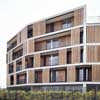
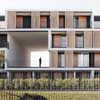

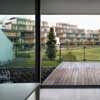
photos from OBR Open Building Research
How does this project embody your thinking about for providing homes in the 21st century?
In line with ever changing developments in contemporary living, the porosity of the architecture makes Milanofiori residential complex an evolving organism, in perpetual change, preferring the dynamic exchange between architecture and nature and stimulating the interaction between man and environment.
In this sense we believe that today we are more interested in a new idea of living space which instead of closing to protect an inner energy to preserve, it opens itself to exchange. Outside there is the greatness of nature (the sun, the wind, the rain, the light, the dark..). Then it is a matter of how much you decide to play with this porosity depending on your needs/desires.
What were the major challenges you faced realising this project? How did you overcome them?
The Milanofiori project investigates new ways of contemporary living by developing three themes. Nomadism and sedentary. Contemporary life brings each of us to live a house as a place where you come from and where you come back to, in a continuous alternation of time and space. This means that sedentary and nomadism attitude coexists in our every day living experience. To express this duality it is not enough to think just in terms of housing types that meet the most varied requirements of all possible users. It is needed instead a paradigm shift that lies in reversing the direction of the discussion: from the house as an object to the inhabitant as the subject.
Living in the garden. Breaking free from the presence of the hypertrophic “house”, the dwelling is thought more as the expression of the site as a whole, rather than a physical place. This is not simply blurring the distinction between inside / outside, but finding the continuum in which space and time are unified in one entity that cannot be separated. To do this we need to think of an opportunity: the garden. In the garden space and time are unified, they become continuous, recovering – evoking – the essential meaning of living in the sense of “taking care”.
From collective complex to “polyvalent-interconnected system”. The project involves a series of open spaces for social interaction in synergy with other parts of the cluster. In this sense, the typical user lives an “interconnected life”, with multiple possibilities of movement even within the same cluster. We try to overcome the concept of “Unity” (d’Habitation) in favour of a polyvalent system that overcomes the typical nuclear family separation between housing and workplace, towards new models of mutual relations, trade and transversality.
Please could you supply us with a short practice history also. (number of employees, year founded, principal architects/directors, major works both completed and upcoming).
OBR Open Building Research has been established in 2000 by Paolo Brescia and Tommaso Principi after working for Renzo Piano, with the idea of creating a design network between Genoa, Milan, London and New York, researching new ways of living, working within the confluence of architecture, environment and natural/urban landscape.
They link their working experience with the academic world, lecturing at Politecnico of Milan, Università degli Studi di Roma La Sapienza, Università di Trieste, Kent State University, Accademia di Architettura di Mendrisio, Helsinki Aalto University, Academy of Architecture of Mumbai.
The twenty architects of OBR develop their experimental line through the participation in international projects and design competitions involved in public and social programs in newly advanced urban development countries as China, India, Brazil, Egypt, Morocco and Ghana.
Their research activity is applied in the OBR projects of which the best known internationally are: Museo di Pitagora in Kroton; Galleria Sabauda in the Palazzo Reale of Turin; Milanofiori Nord Residential Complex; Campus Scolastico Divino Amore in Rome; Museo Diocesano of Milan; Lido di Genova; Ospedale dei Bambini in Parma; Ospedale Galliera in Genoa; Fengqing Square in Zhengzhou; Students and Teachers Centre of Shantou University; Genoa Cricket and Football Club; Museums of History and Science & Technology of Dalian.
The projects of OBR have been shown widely, including at 10th Biennale di Venezia (2006), Architecture: Where to, London (2007), V Bienal de Arquitetura in Brasilia (2007), XI Bienal Internacional de Arquitectura in Buenos Aires (2007), AR Award Exhibition in Berlin, Budapest and Seul (2008), China International Architectural Expo in Beijing (2009), Shanghai International Expo (2010).
OBR has been recognised for the architectural design research for which they have gained awards, such as AR Awards honourable mention for Emerging Architecture at the RIBA Royal Institute of British Architects in London (2007), Plusform award for Best architecture realized by young architect under 40 (2008), Urbanpromo by INU Istituto Nazionale Urbanistica at 11th Biennale di Venezia (2008), honourable mention finalist for the Gold Medal for Italian Architecture at Triennale di Milano (2009), Europe 40 Under 40 in Madrid (2010), In/Arch and Ance premium in Rome for the best realised project in Italy designed by young architect (2011), Leaf Leading European Architects’ Forum Awards overall winner (2011).
Milanofiori Residential Complex information received 231111
Milanofiori Housing Complex : LEAF Awards Shortlisted Building, 2011
2 Aug 2011
Milanofiori Housing Complex
OBR Open Building Research complete Milanofiori housing
Design: OBR Open Building Research
The Milanofiori housing complex is part of the master plan by Erick van Egeraat characterized by a series of functions (offices, hotels, restaurants, cinemas, leisure, residences) that define together a cluster whose elements appear to follow the characteristics of the surrounding landscape creating a public park as the extension of the existing forest. The design seeks the symbiosis between architecture and landscape, so that the synthesis of artificial and natural elements could define the quality of living and the sense of belonging by the inhabitants.
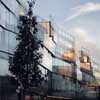
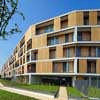
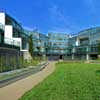
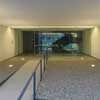
photos from OBR Open Building Research
The interface between the building and the garden becomes the field where interaction between man and environment takes place. This interface is defined by the “C” form of the complex which encompasses the public park, and by the porosity from interior to exterior that characterizes all 107 apartments. The two facades are designed differently: the one facing the street outside is more urban, and the one towards the inner park is more organic.
The design of the urban facade stimulates a sense of belonging thanks to the composition of white frames which identify separately the units. These frames include vertical wooden panels of different widths which can slide across the frames and control the inner light as necessary.
The organic facade overlooking the garden features double glazed bioclimatic greenhouses.
The co-planarity between the glass of the greenhouse and the glass guardrail covering the string-course creates an effect where the shape of the construction and the background merge and reverse their roles constantly, producing kaleidoscopic effects overlapping the reflection of the public garden outside with the transparency of the private garden inside.
The winter garden has a double value: an environmental value in providing a buffer zone which allows thermal regulation, and an architectural value in allowing extension of the interior living space towards the exterior landscape (and vice versa) permitting different uses from summer to winter.
Through the overlap of different natural layers (the public park, the open terraces and the winter gardens) the project seeks a kind of a holism of nature, where various personal interactions of these natural layers create an intensive landscape that is directly and personally customized by each resident.
The Milanofiori project investigates new ways of contemporary living by developing three themes.
Nomadic and sedentary. Contemporary life brings each of us to live a house as a place where you come from and where you come back to, in a continuous alternation of time and space.
This means that sedentary and nomadic attitude coexists in our every day living experience. To express this duality it is not enough to think just in terms of housing types that meet the most varied requirements of all possible users. It is needed instead a paradigm shift that lies in reversing the direction of the discussion: from the house as an object to the inhabitant as the subject.
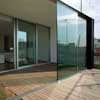
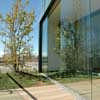


photos from OBR Open Building Research
Milanofiori Housing Complex – Building Information
OBR design team:
Paolo Brescia e Tommaso Principi
Chiara Pongiglione, Francois Doria, Laura Anichini, Silavia Becchi, Antonio Bergamasco, Paolo Caratozzolo Nota, Giulia D’Ettorre, Julissa Gutarra, Leonardo Mader, Elena Mazzocco, Margherita Menardo, Paolo Salami, Izabela Sobieraj, Paula Vier, Francesco Vinci, Fabio Valido, Barbara Zuccarello
Project team:
OBR S.r.l.
Favero & Milan Ingegneria S.p.A.
Studio Ti S.r.l.
Buro Happold Ltd
Vittorio Grassi
Site surveyor: Favero & Milan Ingegneria S.p.A. / Alessandro Bonaventura
Project management: P&P S.r.l. / Luigi Pezzoli
Client: Milanofiori 2000 S.r.l. / Gruppo Cabassi
Location: Assago, Milano, Italy
Dimensions: site area 30.000 sqm ; built area 27.400 sqm (107 apartments)
Contractor: Marcora S.p.A. – Cile S.p.A.
Chronology:
2005 Design competition (1st prize)
2005 Preliminary design
2006 Definitive project
2007 Construction documents
2010 Realized
Award: 2010 European 40 Under 40, Madrid
Milanofiori Housing Complex images / information from OBR Open Building Research
Milanofiori Residential Development is shortlisted for the LEAF Awards 2011
Location: Milanofiori, Milan, Lombardy, northern Italy
Milan Architecture
Contemporary Milanese Architecture
Milan Building Designs – chronological list
Milan Architecture Tours – city walks by e-architect
Milan Architects Offices – architectural firm contact details on e-architect
Milanofiori North – Business Park & Leisure Centre
Erick van Egeraat
Milanofiori North
Milan Architecture – Selection
Matteo Thun & Partners
Tortona 37
Foster + Partners
Santa Giulia Milano
Milan hotel towers
Dominique Perrault
Milan Hotel Towers
Comments / photos for the Milanofiori Housing Complex page welcome
Website: n/a

